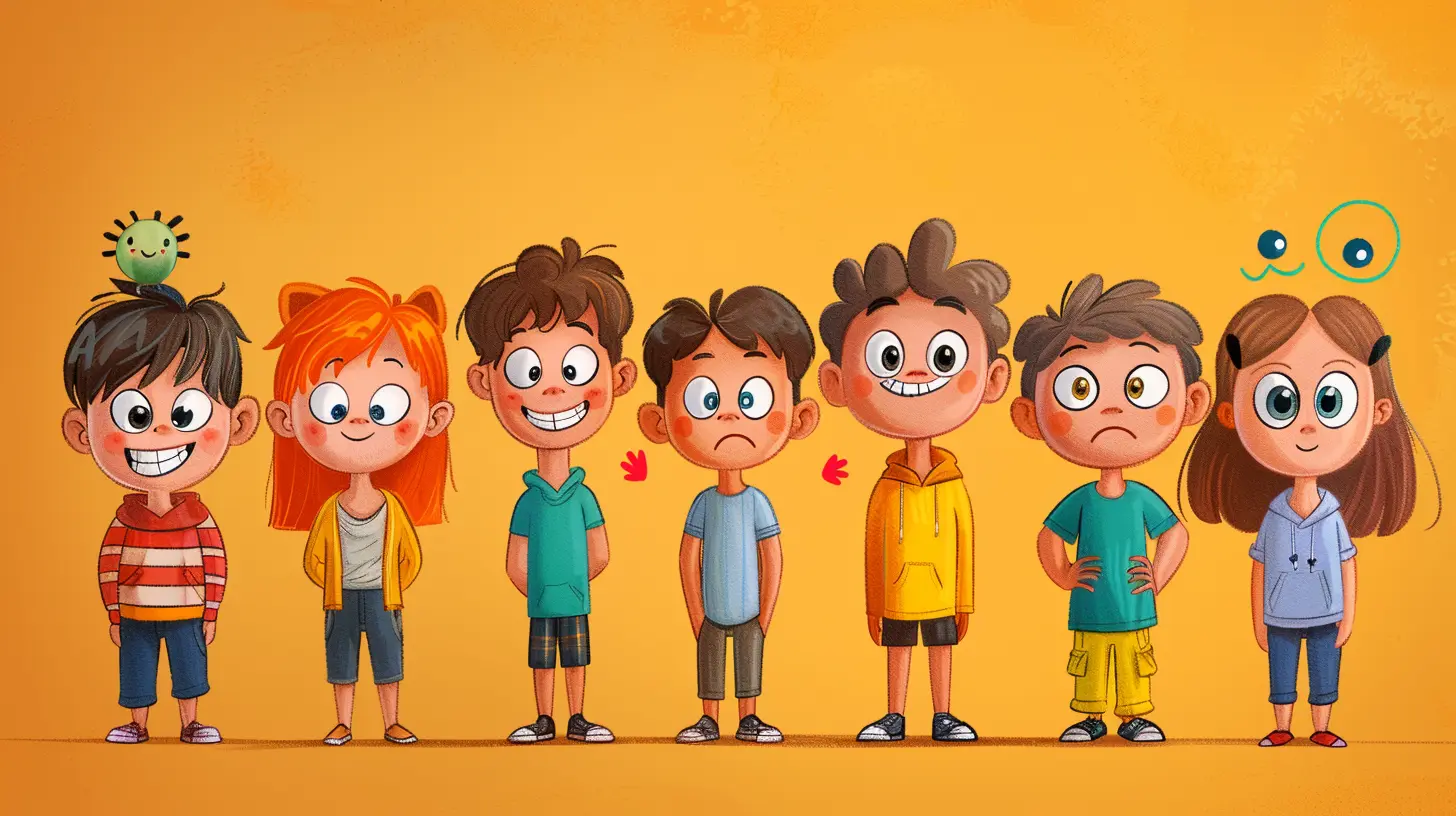Teaching Your Child to Understand and Accept All Emotions
2 May 2025
Let’s face it—emotions are tricky little things. One minute, you’re a calm, collected adult sipping a cup of coffee. The next, you’re sobbing because your kid hugged you and said, “You’re the best mommy/daddy ever.” (It’s fine, everyone cries over cute things. Totally normal.) But if we, as adults, still trip over the maze of emotional highs and lows, how do we even begin to teach our kiddos to understand and accept all of their emotions?
Spoiler alert: It takes more than just telling them, “Don’t cry, it’s no big deal,” or the classic “Just calm down.” (Let’s be real here—when has anyone ever ‘just calmed down’ because someone told them to? Exactly.)
This article dives into the nitty-gritty of raising emotionally intelligent, empathetic little humans—all while keeping it as lighthearted and relatable as possible. Humor definitely makes all those parenting brain cramps feel a little less… migraine-y. 
Why All Emotions Are Equally Important
Let’s clear something up right away: not all emotions feel good, but they all serve a purpose. Think of emotions like a toolbox. Joy is the shiny, easy-to-use screwdriver. Anger is the big ol’ hammer you pull out when nothing else works. Sadness? That’s the wrench; it helps you loosen up and dig deep into what’s really going on.If kids don’t learn early on that every emotion has value, they’ll grow up thinking they need to shove the "bad ones"—like anger, fear, or sadness—into a back closet. And trust me, that emotional closet tends to explode at the worst possible times (think: public meltdowns or grown-up relationship dramas). 
Step 1: Name It to Tame It
Ah, the good ol’ “name it to tame it” trick. Sounds fancy, but it’s basically just teaching your kid to put words to their emotions.Picture this: Your kid is lying facedown on the kitchen floor, screaming because you gave them the "wrong" color cup. (Been there?) Instead of immediately launching into a lecture about "cup equality," take a deep breath and ask, “Are you feeling frustrated because this wasn’t the cup you wanted?”
Why does this work? Because identifying emotions is step one to managing them. Naming emotions gives the brain a chance to pause and cool down. Plus, it gently teaches your toddler (or even your angsty teen) that feelings aren’t these overwhelming, nameless monsters—they’re something they can learn to handle. 
Step 2: Model Emotional Acceptance
Kids are the world’s most observant little creatures. If you stub your toe and mutter, “I’m fine” while your face is clearly screaming pain, they’ll notice. They watch how you deal with emotions like they’re studying for a test.So, the next time you’re frustrated because someone cut you off in traffic (again!), narrate your feelings. Say something like, “Wow, I’m really annoyed right now! That was dangerous, but I’ll take a deep breath and let it go.”
This not only shows them that emotions are okay, but it also demonstrates healthy coping strategies in real-time. You’re basically their emotional GPS—helping them navigate the messy world of feelings. 
Step 3: Create a Safe Space for Big Feelings
Here’s the thing about kids: they need to feel safe to let their feelings out. If they sense that their emotions are “too much” or “wrong,” they’ll stuff them down faster than leftover cake at a birthday party.Creating a safe space can be as simple as saying, “It’s okay to feel sad/mad/angry right now. I’m here if you want to talk about it or just want a hug.”
Pro tip: Avoid minimizing their feelings. Saying things like, “You shouldn’t feel that way,” or “That’s not a big deal,” teaches them to doubt their own emotions. Instead, validate and empathize. “I can see why that upset you—that must’ve been so frustrating!” is a parenting MVP move.
Step 4: Teach Them Healthy Outlets
Emotions need somewhere to go. It’s like shaking up a soda bottle—if you don’t open it slowly and carefully, BOOM. Emotions work in the same way.Encourage your child to vent their feelings in healthy ways, whether that’s journaling, drawing angry tornadoes, dancing out their excitement, or literally screaming into a pillow. (Yes, the scream-pillow combo works wonders—don’t knock it 'til you try it.)
For little ones, something as simple as squishing Play-Doh when they’re upset can release pent-up frustration. For older kiddos, taking a walk or talking it out can be game-changers.
Step 5: Help Them Problem-Solve
Here comes the practical part: teaching kids to work through their emotions. This doesn’t mean fixing everything for them (no helicopter parenting, please), but leading them to think critically about their feelings.If they’re crying because their toy broke, ask gentle questions like, “What do you think we can do to fix it?” or “Would you like me to help?” Asking questions shows them that emotions aren’t just problems—they’re signals prompting action.
Learning to problem-solve is like giving them emotional training wheels. Eventually, they’ll be cruising through tricky situations without needing a push from you.
Step 6: Introduce the Emotion Spectrum
Okay, here’s a fun visual exercise: teach them that emotions exist on a spectrum. For example, anger isn’t just one big, scary feeling—it can range from slight irritation to full-blown fury.Think of it like a spice rack. Anger could be a dash of paprika when your sibling takes the last cookie or full-on ghost pepper when someone steals your favorite toy. Helping them understand this range makes emotions feel less overwhelming—and more manageable.
You can even make it a game! Create an “Emotion Thermometer” where they point to how they’re feeling on the scale. It’s simple, yet surprisingly effective.
Busting the Myth of “Good” and “Bad” Emotions
One of the biggest lessons you can teach your child is that emotions aren’t “good” or “bad.” They just are.Happiness isn’t better than sadness, and fear doesn’t make someone weak. It’s all part of being human! Even anger—which gets a seriously bad rap—is just your brain’s way of saying, “Hey! Something’s not right here!”
Teaching your child emotional neutrality helps them accept their feelings without shame or judgment. Because let’s be honest, the last thing the world needs is another generation of people who think crying is a weakness. (Hug your inner child. They probably need it too!)
When They Struggle to Open Up
Some kids are like emotional open books. Others? Lock box. If your child struggles to talk about their feelings, don’t push them. Instead, give them tools to express themselves at their comfort level.Try asking open-ended questions like, “What’s been the best/worst part of your day?” Or introduce fun conversation starters like, “If your feelings were animals today, what would they be?”
And remember, sometimes kids open up when they’re doing something else—cooking, coloring, or kicking a ball around. Be ready to chat when they’re ready to share.
Celebrate Emotional Wins
When your child successfully handles a big feeling or expresses themselves clearly, celebrate it! Let them know how proud you are.Statements like, “Wow, you did such a great job explaining how you felt,” can boost their confidence and reinforce positive behavior. Emotional intelligence is a skill, and like learning to ride a bike, it takes practice and encouragement.
A Quick Note for Parents: Be Kind to Yourself
Teaching emotions is tricky. Sometimes, you’ll lose your patience or wish you’d handled a situation differently (hello, parenting guilt!). But remember, you’re learning too. No parent has it all figured out, and that’s okay.The fact that you’re even trying to teach your child emotional intelligence puts you miles ahead. So, pat yourself on the back—you’re doing amazing.
Wrapping It All Up
Teaching your child to understand and accept all emotions is a lifelong journey. It’s not about perfection—it’s about progress. When you give them the tools, vocabulary, and support to navigate their feelings, you’re setting them up for a lifetime of emotional resilience.Will they still cry over the "wrong" cup? Probably. But one day, they’ll carry these lessons into their own relationships, careers, and lives. And that, my friend, is parenting gold.
all images in this post were generated using AI tools
Category:
Emotional DevelopmentAuthor:

Austin Wilcox
Discussion
rate this article
4 comments
Blade Lewis
What a fascinating topic! I’m curious about how we can effectively model emotional acceptance for our kids. Are there specific techniques or activities that you’ve found particularly helpful in fostering a safe space for children to explore their feelings? I’d love to hear more about the practical steps parents can take!
May 19, 2025 at 3:10 AM

Austin Wilcox
Thank you for your interest! Some effective techniques include using emotion charts to identify feelings, engaging in role-playing scenarios to practice emotional responses, and creating a “feelings journal” where kids can express their emotions through writing or drawing. Consistent open conversations about feelings in a safe environment also help children feel validated and understood.
Juniper McLoughlin
Embracing all emotions fosters resilience and empathy in children’s emotional development journey.
May 5, 2025 at 3:56 AM

Austin Wilcox
Thank you! Embracing emotions indeed lays a strong foundation for resilience and empathy in children, helping them navigate their emotional landscape with confidence.
Gabriella Malone
Great insights on fostering emotional intelligence in children—thank you for sharing!
May 4, 2025 at 4:17 AM

Austin Wilcox
Thank you for your kind words! I'm glad you found the insights helpful!
Runehart McNulty
This is such an important topic! Helping children navigate their emotions fosters empathy and resilience. Your insights provide valuable tools for parents, encouraging open conversations that lead to emotional intelligence. Thank you for sharing!
May 3, 2025 at 4:33 PM

Austin Wilcox
Thank you for your thoughtful comment! I'm glad you found the insights valuable for fostering empathy and emotional intelligence in children.



